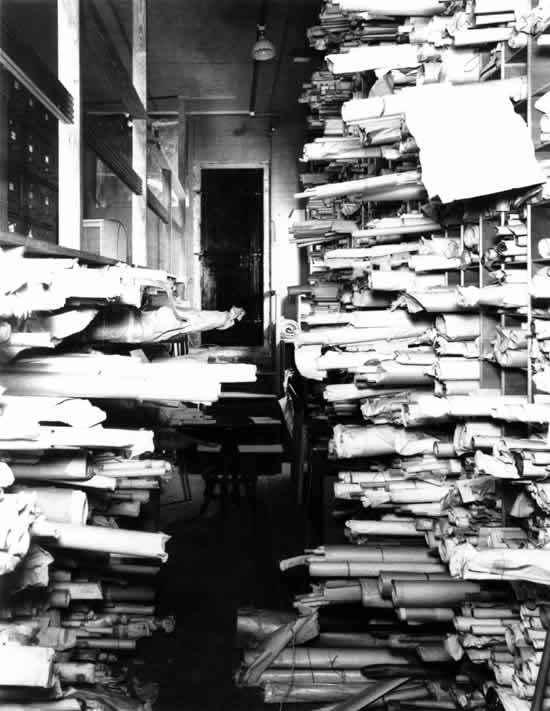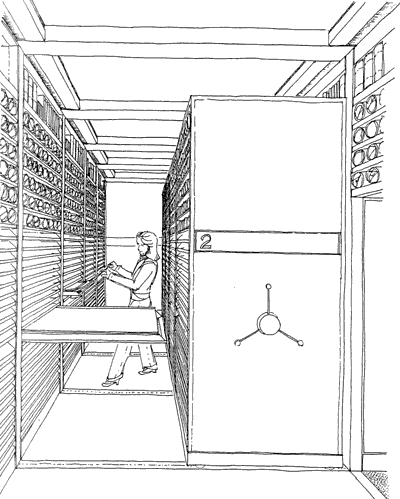Archives Preservation Update
Making a Molehill Out of a Mountain: The Olmsted Plans and Drawings Processing Project
by Diana Alper
When speaking of the size of an archives one usually uses linear or cubic feet. However, many archives cannot be measured using these standards. the Frederick Law Olmsted Archives features an estimated 140,000 landscape architectural drawings and plans relating to 5,000 individual projects dating from the 1860s to -1980. These records, on a variety of supports, range in size from two inches square to 65 inches by fifty feet (in two twenty-five foot sections). This paper will outline the development of a processing, conservation, and storage project for large-format materials on a grand scale.
Frederick Law Olmsted is considered to be the father of American landscape architecture. Having experimented with life as a sailor, farmer, writer and adventurer, Olmsted finally discovered his calling at the age of 35.
Upon his return from an 1850 visit to Birkenhead Park, a public area outside Liverpool, he joined talents with Calvert Vaux and designed Central Park on Manhattan Island. in 1883 Olmsted moved to Brookline, Massachusetts and established a firm dedicated to the burgeoning field of landscape architecture. in time the house grew to be a bustling complex of buildings dedicated to the business of designing major metropolitan park systems, parks and parkways, our national and many state capitol grounds, school and college campuses, residential suburbs, arboretums, and private estates. Over its one hundred year history the Olmsted firm, carried on after Olmsted's death by his sons and successors, was involved in the design of some 5000 individual landscape projects
In 1979, Congress established the Frederick Law Olmsted National Historic Site in order to preserve and interpret the home and office of Frederick Law Olmsted. the legacy includes 100 years worth of records relating to the business of landscape architecture. These records include financial papers, correspondence, reference collections, and photographic prints and negatives. "Traditional format" collections such as these are processed and preserved according to long established preservation standards. the drawings and plans, however, presented challenges for Processing and preservation issues.
In terms of archival processing, the quantity of drawings and plans, estimated at 120,000-140,000, is not daunting; the physical size of each item and its special handling demands pose special challenges. the Olmsted National Historic Site is currently in the third year of a ten year project to gain intellectual control over and stabilize this historically significant collection.
Figure 1.
The drawings and plans were stored, in 54-inch long cubbyholes, (Figure 1) until the National Park Service arrived on the scene. This storage area lacked adequate climate control, promoting both chemical and physical damage. Drawings and plans requiring chemical stabilization are treated in an on site conservation laboratory. for example, resin impregnated tracing papers are treated as reported by Janet L. Stone, ICOM Committee for Conservation, 1987, Volume II. However, only about 3% of the drawings and plans require immediate chemical treatment. the remaining drawings require more efficient cataloging and stabilization. This work is conducted by a team of museum technicians, trained in-house to perform treatments developed specifically to address the unique goals of the project.
In 1983 an inventory was taken of all the rolls of drawings in the storage vault, built by the Olmsted firm in 1901 and expanded in 1911/12, in preparation for renovations to the interior. Information from the exterior of a roll of drawings was recorded without the benefit of unrolling. As a result, the quantity of drawings and their condition is still unknown. During the inventory, drawings were removed cubbyhole by cubbyhole to 2700 storage tubes purchased from an ice cream container manufacturer. These tubes and their caps were made with an alkaline adhesive with a neutral paper interior. the tubes of drawings were then moved off site to the Springfield Armory National Historic Site, where many of them remain today.
Modeled after the Library of Congress' concept of phased preservation, these storage tubes are considered this project's first phase. They provide physical control over the collection and buffer them from damaging environmental elements. As part of the ten year project the museum technicians are currently performing the second phase: inventory (basic level cataloging), stabilization (basic treatments and rehousing), and identification of drawings requiring complex or chemical treatment. the final phase is handled by a staff conservator.
After several pilot phases utilizing the large historic drafting spaces in the Olmsted Office, the project was launched in the late 1980s. We developed streamlined techniques and adopted a production line approach to the inventory and conservation process. It was quickly discovered that performing an individual treatment on batches of drawings was more efficient than working on one drawing at a time. at full production the Brookline staff was handling 150-200 drawings per week. Once treatment procedures were in place, we were able to double production by having two facilities dedicated to the task. in the summer of 1989 a second technician-level laboratory was opened in Springfield. It seemed to make sense that since the drawings were to be returned to Brookline for final storage--they should come back ready to store.
Museum technicians inventory, surface clean, humidify and flatten, mend tears, and rehouse and check drawings into the vault. During the inventory stage, provenance is recorded at the item level and drawings are lightly brushed to remove loose dirt. Drawings requiring a more thorough surface cleaning are cleaned using Mars Plastic erasers, ground in a mechanical cheese grater. Historically grouped drawings are then separated according to size and support which dictate their treatment needs.
The largest flat drawer size is 40 X 60 inches; any drawings larger than this will be stored rolled. Most over-sized drawings are therefore able to by-pass humidification and flattening. a distinction is also made between drawings to be stored flat and those to be stored rolled, if these items require mending. Because handling makes oversized drawings more vulnerable to damage, these drawings are mended as completely as possible. Drawings to be stored flat are mended to the extent necessary to insure safe handling. Finally, items are foldered or rolled onto tubes for storage.
The first consideration for storage is physical safety; drawings are stored in size order. the second consideration is chemical stability; regardless of their size, drawings are placed into enclosures which are sympathetic to their chemical needs, e.g., blue and heliographic prints are placed in polyester to provide a neutral environment and tracing papers are interleaved with buffered tissue. Intellectual order is the final consideration; drawings historically stored together are reunited only after physical and chemical needs are addressed.
Figure 2.
Drawings smaller than 40 by 60 inches are stored in custom designed and constructed lightweight, shallow drawers (three sizes: 18 X 24, 30 X 40, and 40 X 60 inches) each holding approximately five folders of fifteen drawings. the drawers are designed so that each may be removed from the shelving framework and carried vertically by two people to large sorting tables located outside the storage vault (Figure 2). the drawer bottoms are constructed of fiberglass with a hexagonal metal core for strength. the rest of the unit, including the sides of the drawers are of anodized aluminum. the drawers ride on nylon rather than metal runners. They operate exceptionally well and do not produce metal shavings.
Drawings larger than 40 by 60 inches are rolled onto three-inch diameter tubes, approximately ten drawings per roll. the rolls of drawings are wrapped in pre-cut sheets of polyester and secured with pressure sensitive Velcro. the Velcro is cut into two inch strips; if the roll increases or decreases in size, it may still be secured. the rolls of drawings are placed in four-and-one-half-inch tubes and stacked on shelves forming a honeycomb network to provide maximum storage space. Those drawings which cannot physically be rolled on three-inch tubes are rolled on larger tubes and inserted into tubes as large as seven-inches in diameter. We will be providing limited flat storage for particularly fragile drawings smaller than approximately five by twelve feet. Design and construction oversight are provided by an architect. under contract.
This project also includes plans for the development and implementation of a relational data-base as well as microformatting. the data-base will link the plans and drawings with other record groups in the archives and provide efficient access .
The Olmsted plans and drawings processing project combines collection specific conservation treatments with archival based ethics to provide for the long-term preservation needs of these large format materials. Museum technicians are trained to perform specific treatments based on the particular needs of the collection. Efficient batch treatments are stressed to ensure that all of the drawings will be stabilized within ten years. the large quantity of drawings dictates addressing this record group as a whole. We will return later to perform complex time-consuming treatments once all the drawings have been stabilized.
Diana AlperIllustrations courtesy of: National Park Service, Frederick Law Olmsted National Historic Site
Regional Preservation Coordinator, Preservation Policy & Services Division
National Archives & Records Administration
Publication History
Received: Fall 1992
Paper delivered at the Book and Paper specialty group session, AIC 20th Annual Meeting, June 2-7, 1992, Buffalo, NY.
Papers for the specialty group session are selected by committee, based on abstracts and there has been no further peer review. Papers are received by the compiler in the Fall following the meeting and the author is welcome to make revisions, minor or major.

